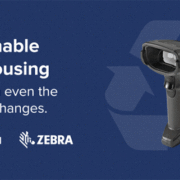Shaping modern warehousing from the inside out, demands for sustainable practices have skyrocketed, with a 71% increase in searches for sustainably sourced and packaged products. To retain customer loyalty, warehouses and distribution centers can no longer afford to overlook operational sustainability. Moreover, as supply chain issues continue, eco-friendly practices can also help minimize costs and downtime since versatile technologies aim at reducing e-waste, thus streamlining several vital workflows through one rugged device for less future decommissioned devices. In addition to a smaller carbon footprint, sustainable warehousing promotes:
- Consolidated workflows for less deployed devices and reduced management costs
- Future-proof operating systems to prevent early decommissioning
- Durable printheads and smooth surface labels that mitigate premature printhead failure
- Less paper-based data tracking thanks to automated scanning capabilities
Explore your sustainable modernization options
To further facilitate your sustainable plan, next-generation technologies strive to support the qualities discussed above. For example, Zebra’s Rugged Tablets hold EPEAT certifications, thus complying with multiple stringent standards while automating data capture. Whether through rugged tablets or mobile computers, sustainable warehousing can be achieved through…
- Eco-friendly upgrades that guarantee proper recycling – As businesses move toautomate repetitive tasks, concerns for improper e-waste disposal grow. To prevent outdated devices from hitting landfills, Avalon continues in its partnership with the GO Zebra Program, assisting businesses in trading legacy devices from any manufacturer for Zebra’s next-evolution devices along with cash rebates up to $650 per device.
- Minimum operational lifespan of five to ten years for mobile devices – Unlike consumer-grade devices which typically last between one to two years, enterprise-devices running on Android’s OS can last up to 10 years with uncompromised data security thanks to silent yet recurring updates and security patches.
- Durable external design to withstand rough use – Optimize reliable operations with durability that is built to handle drops to concrete, rain, snow, dust, extreme heat, subzero temperatures, and liquids. Zebra’s Rugged Tablets are waterproof, dustproof, and drop-proof, so your workers get the ultimate in usability. When devices are built to survive harsher conditions, businesses can also avoid wasteful downtime and breakdowns, decreasing operational costs, IT visits, and eventual device disposal.
- Reliable battery management – Lastly, to reduce risks of improper battery disposal and sudden device malfunction, applications similar to Zebra’s PowerPrecision can pinpoint a battery’s lifespan and performance. This enables workflows to preempt problems before they impact productivity while tracking retired batteries to prevent improper disposal.
With the correct technologies, even the smallest changes can greatly improve sustainable warehousing. For more small-scale changes and implementations, contact Avalon’s modernization experts to learn more.



